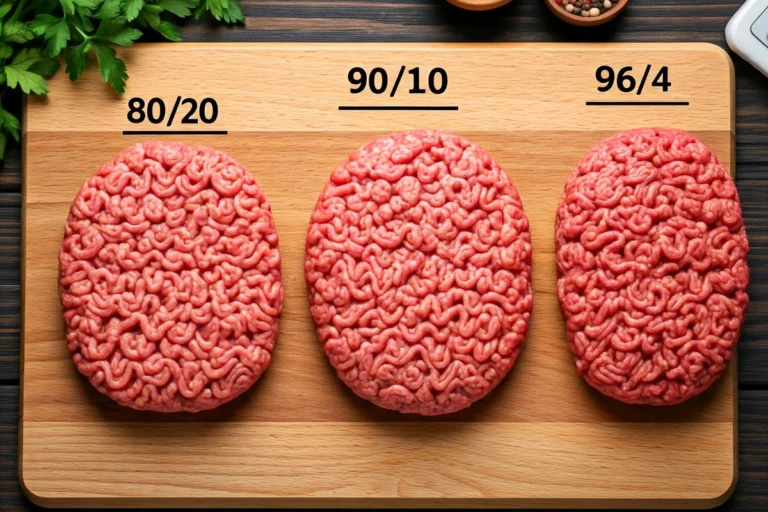Ground beef is a kitchen staple for its versatility and rich taste, but have you ever wondered just how much protein in ground beef makes it such a powerhouse? From tacos to meatloaf, ground beef isn’t just about flavor—it’s packed with nutrients, especially protein, that fuel our bodies. In this article, we’ll break down the protein content in ground beef, explore its benefits, and provide tips for incorporating it into your meals without compromising on health.
Whether you’re cooking for your family, meal-prepping for the week, or tracking your macros, this guide will answer all your questions and more. Let’s dig in!
Understanding Protein Content
What Makes Ground Beef a Protein Powerhouse?
Ground beef is celebrated not just for its taste but also for its high protein content, making it a go-to ingredient for fitness enthusiasts and busy families alike. The amount of protein in ground beef depends on its lean-to-fat ratio. For instance, 90% lean ground beef contains about 23 grams of protein per 3-ounce serving, while fattier varieties like 80% lean offer slightly less due to their higher fat content.
Protein is essential for building and repairing tissues, supporting muscle growth, and maintaining a healthy immune system. Unlike many other protein sources, ground beef is a complete protein, meaning it contains all nine essential amino acids your body can’t produce on its own.
Factors Affecting Protein Content
Several factors influence the protein content in ground beef:
- Lean-to-Fat Ratio: Higher lean percentages mean more protein per ounce. For example, how much protein in ground beef increases with leaner cuts like 96% lean, which offers up to 26 grams per serving.
- Cooking Methods: Cooking ground beef causes water loss, which can concentrate protein but slightly reduce its overall weight. Boiling, grilling, or pan-frying may all yield different results.
Ground beef is not only delicious but also a reliable source of nutrient-dense protein that fits into a variety of diets. From high-fat keto plans to lean, muscle-building meals, there’s a type of ground beef for everyone.
Protein in Raw vs. Cooked
How Protein Content Changes with Cooking
Cooking ground beef alters its composition, especially its protein density. When you cook ground beef, the water content evaporates, which makes the beef weigh less. This concentration of nutrients, including protein, results in cooked ground beef having a slightly higher protein content per ounce than its raw counterpart.
For example, 3 ounces of raw 80% lean ground beef contains about 18 grams of protein, while the same weight of cooked beef may contain up to 22 grams. The difference lies in the reduction of water weight, which concentrates the protein. However, cooking at excessively high temperatures can denature proteins, reducing their bioavailability.

Protein Density
The amount of protein depends heavily on its cooking method. For instance:
- Grilling or broiling: These methods reduce fat content, increasing the protein-to-fat ratio.
- Pan-frying: While effective, it retains more fat, slightly lowering the protein density.
- Boiling or simmering: These methods maintain the protein content but may result in softer textures, perfect for soups or sauces.
Curious about how much protein remains after cooking? On average, cooked ground beef retains 85-90% of its protein content, with minimal losses during preparation.
For more tips on selecting and preparing ground beef, explore this Ground Beef Guide for expert advice.
Protein by Serving Size
Protein in 1 Cup
Measuring protein by serving size provides clarity for meal planning. A 1-cup serving of cooked ground beef (approximately 5.5 ounces) contains about 35 grams of protein in an 80% lean-to-fat ratio. Leaner cuts like 90% lean ground beef can pack up to 40 grams of protein per cup, thanks to their reduced fat content.
For raw ground beef, protein content varies slightly due to moisture loss during cooking. A cup of raw 80% ground beef offers around 30 grams of protein, which increases proportionally after cooking.
Protein in 1 Pound
If you’re planning a family meal or meal prepping, knowing how much protein in ground beef is in a pound is key.
- 1 pound of 80% lean raw ground beef contains about 72 grams of protein.
- After cooking, the same pound provides roughly 90 grams of protein, depending on cooking techniques and fat drainage.
Whether you’re grilling burgers or making a hearty chili, ground beef offers an efficient way to meet your daily protein needs. Let me know when you’d like to continue with the next parts!
Comparing to Other Meats
Ground Beef vs. Chicken
When it comes to protein content, ground beef and chicken both have their advantages. A 3-ounce serving of cooked chicken breast contains about 26 grams of protein, slightly edging out 90% lean ground beef, which has around 23 grams of protein. However, the taste and texture of ground beef often make it a preferred choice for certain recipes like burgers or meatloaf.
Ground beef also provides more iron and zinc than chicken, making it an excellent option for individuals with higher nutrient needs. If you’re focusing on how much protein in ground beef supports muscle recovery, lean beef cuts may align better with high-protein diets.
Ground Beef vs. Pork and Fish
Ground beef is a close competitor to pork and fish in terms of protein. A 3-ounce serving of cooked ground pork offers about 22 grams of protein, comparable to beef. However, pork often has more fat, which can increase calorie intake.
Fish, such as salmon or tuna, provides around 20-22 grams of protein per serving, but it stands out for its omega-3 fatty acids. While ground beef lacks these heart-healthy fats, it is easier to integrate into everyday recipes for quick meals.
If you’re exploring other protein options or want creative ideas, check out this Turkey Cabbage Casserole Recipe for a lighter, high-protein alternative.
Nutritional Benefits Beyond Protein
Vitamins and Minerals in Ground Beef
Ground beef is not just about how much protein you get—it’s also packed with essential nutrients. Beef is rich in iron, which supports oxygen transport in the blood, and zinc, which strengthens the immune system. Additionally, it’s an excellent source of vitamin B12, crucial for energy production and brain function.
Grass-fed beef tends to have slightly higher levels of antioxidants and omega-3 fatty acids than conventional beef. While these differences are minimal, choosing grass-fed options can provide a nutritional boost.
Complete Protein Source
Unlike many plant-based proteins, ground beef is a complete protein, meaning it contains all nine essential amino acids your body needs. These amino acids are vital for muscle repair, hormone production, and enzyme functions.
For a hearty dish that balances protein with other nutrients, try incorporating ground beef into soups or casseroles. Its nutritional value makes it an ideal ingredient for building balanced meals.
Lean Ground Beef and Protein Goals
Best Cuts for High Protein and Low Fat
If you’re aiming to hit specific protein goals, choosing the right ground beef can make all the difference. 96% lean ground beef is one of the best options for those focused on high protein and low fat. A 3-ounce serving of this cut provides around 26 grams of protein with only 2-3 grams of fat. This makes it an excellent choice for calorie-conscious diets or those looking to maximize protein intake without adding too much fat.
On the other hand, 90% lean ground beef strikes a good balance between flavor and nutrition. It offers 23 grams of protein per serving while still retaining enough fat to keep dishes juicy and flavorful. These lean cuts are versatile and work well in recipes like stir-fries, tacos, or meatballs.
How to Incorporate Lean Ground Beef into Your Diet
Incorporating how much protein into your meals can be simple and delicious. For example:
- Salads: Add cooked lean ground beef to a bed of greens with fresh vegetables for a protein-packed meal.
- Stuffed Peppers: Use lean ground beef as the filling for bell peppers, mixing it with quinoa or rice for a complete dish.
- Breakfast Bowls: Sauté ground beef with eggs and spinach for a high-protein start to your day.
Lean ground beef pairs easily with other healthy ingredients, making it a go-to option for meeting dietary protein needs.
Recipes for Maximizing Protein Intake
Packed Recipes
Ground beef is one of the easiest ways to create protein-rich meals that satisfy your hunger. Here are some simple yet effective recipes for increasing your protein intake:
- High-Protein Chili: Combine 96% lean ground beef with kidney beans, tomatoes, and spices. This hearty dish delivers over 30 grams of protein per serving while keeping fat content low.
- Stuffed Zucchini Boats: Hollow out zucchinis and stuff them with cooked ground beef, diced onions, and a sprinkle of cheese. This quick dish is packed with how much protein and essential nutrients from vegetables.
- Low-Carb Meatballs: Use almond flour instead of breadcrumbs to create a keto-friendly, protein-rich meatball recipe that pairs well with zucchini noodles or marinara sauce.
These recipes highlight the versatility of ground beef in crafting balanced, high-protein meals.

Portion Control and Balancing Macros
When incorporating ground beef into your diet, portion control is essential. For example, a 4-ounce serving of 90% lean ground beef provides around 30 grams of protein, making it a perfect addition to a post-workout meal. Pairing ground beef with fiber-rich sides like roasted vegetables or whole grains ensures a balanced plate.
If you’re looking for more ideas, explore this Ground Beef Guide for additional recipes and tips.
Tips for Buying and Storing Ground Beef
How to Choose the Best Ground Beef
Selecting the right ground beef starts with understanding how much protein in ground beef aligns with your dietary needs. Look for labels indicating the lean-to-fat ratio, such as 90/10 or 96/4, to maximize protein content while minimizing fat. Grass-fed beef is a great option for its slightly higher nutritional value and richer taste.
When shopping, choose ground beef with a bright red color on the surface—this indicates freshness. Avoid packages that look gray or brown unless they’re vacuum-sealed, as color changes can result from reduced oxygen exposure.
Proper Storage to Retain Nutritional Value
Storing correctly ensures it retains its quality and protein content. Follow these tips for optimal storage:
- Refrigeration: Use ground beef within 1-2 days of purchase to maintain freshness.
- Freezing: Wrap portions tightly in plastic wrap or aluminum foil, then place them in freezer bags. This helps preserve protein and prevents freezer burn.
- Thawing: Always thaw ground beef in the refrigerator, not on the counter, to avoid bacterial growth.
For more storage and cooking tips, check out other helpful guides on Goldy Recipe.
FAQs
How Much Protein Is in 4 Ounces?
For those tracking macros, knowing the exact protein content of your portions is essential. A 4-ounce serving of 90% lean ground beef contains approximately 30 grams of protein, while the same amount of 80% lean ground beef has slightly less at 28 grams due to its higher fat content. Cooked portions, however, may concentrate protein further due to water loss during cooking.
Does Grass-Fed Ground Beef Have More Protein?
Grass-fed ground beef offers similar protein levels compared to grain-fed beef, with about 22-24 grams of protein per 3-ounce serving. While the protein content is nearly identical, grass-fed beef often contains higher levels of omega-3 fatty acids and antioxidants, providing additional health benefits.
How Does Protein in Ground Beef Compare to Plant-Based Proteins?
Plant-based proteins like lentils or tofu are great alternatives but often lack the complete amino acid profile found in ground beef. For example, a cup of cooked lentils provides 18 grams of protein, which is less than ground beef. Additionally, ground beef’s complete protein profile supports muscle building and overall body functions more efficiently than most plant-based options.
Conclusion
Ground beef is not only a delicious kitchen staple but also a powerful source of high-quality protein. Its versatility makes it a go-to ingredient for a variety of meals, whether you’re preparing hearty chili, protein-packed salads, or low-carb meatballs. Understanding how much protein depends on factors like the lean-to-fat ratio, cooking method, and serving size is key to making informed dietary choices.
With options ranging from 80% lean to 96% lean, ground beef can cater to diverse nutritional needs. It’s also rich in essential nutrients like iron, zinc, and vitamin B12, making it more than just a protein source. By pairing it with fresh vegetables, whole grains, or healthy fats, you can create balanced meals that support your health and fitness goals.

